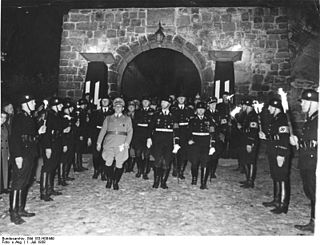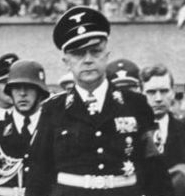Related Research Articles

Karl Eberhard Schöngarth was a German SS functionary during the Nazi era. He was a war criminal who perpetrated mass murder and genocide in German-occupied Poland during the Holocaust.

The uniforms and insignia of the Schutzstaffel were paramilitary ranks and uniforms used by the Schutzstaffel (SS) between 1925 and 1945 to differentiate that organization from the regular German armed forces, the German state, and the Nazi Party.

Reichsführer-SS was a special title and rank that existed between the years of 1925 and 1945 for the commander of the Schutzstaffel (SS). Reichsführer-SS was a title from 1925 to 1933, and from 1934 to 1945 it was the highest rank of the SS. The longest serving and most noteworthy office holder was Heinrich Himmler.

The Allgemeine SS was a major branch of the Schutzstaffel (SS) paramilitary forces of Nazi Germany, and it was managed by the SS Main Office (SS-Hauptamt). The Allgemeine SS was officially established in the autumn of 1934 to distinguish its members from the SS-Verfügungstruppe, which later became the Waffen-SS, and the SS-Totenkopfverbände, which were in charge of the Nazi concentration camps and extermination camps. SS formations committed many war crimes against civilians and allied servicemen.
The title of SS and police leader was used to designate a senior Nazi Party official who commanded large units of the SS, Gestapo and the German uniformed police (Ordnungspolizei), prior to and during World War II.
Dienstalterslisten der Schutzstaffel der NSDAP, English: SS seniority lists of the NSDAP, were official documents that were issued in book form by the Reichsführung-SS (“SS-Personalamt”) between 1934 and 1945.

Johannes Hendrik Feldmeijer was a Dutch Nazi politician and a member of the NSB.

Johann Baptist Albin Rauter was a high-ranking Austrian-born SS functionary and war criminal during the Nazi era. He was the highest SS and Police Leader in the occupied Netherlands and therefore the leading security and police officer there during the period of 1940–1945. Rauter reported directly to the Nazi SS chief, Heinrich Himmler, and also to the Nazi governor of the Netherlands, Arthur Seyss-Inquart. After World War II, he was convicted in the Netherlands of crimes against humanity and executed by firing squad.

The Reichskommissariat Niederlande was the civilian occupation regime set up by Germany in the German-occupied Netherlands during World War II. Its full title was the Reich Commissariat for the Occupied Dutch Territories. The administration was headed by Arthur Seyss-Inquart, formerly the last chancellor of Austria before initiating its annexation by Germany.

Friedrich Karl Freiherr von Eberstein was a member of the German nobility, early member of the Nazi Party, the SA, and the SS. He was elected to the Reichstag and held the position of the chief of the Munich Police during the Nazi era. Eberstein was a witness at the Nuremberg Trials.
Units and commands of the Schutzstaffel were organizational titles used by the SS to describe the many groups, forces, and formations that existed within the SS from its inception in 1923 to the eventual fall of Nazi Germany in 1945.
The Allgemeine-SS regional commands comprised the regional Allgemeine-SS units (SS-Oberabschnitt) that were part of the units and commands of the Schutzstaffel (SS) during the Nazi era. The regional commands covered Austria and Germany.

The 1st SS-Standarte was a regimental command of the Allgemeine-SS and one of the most important units in the General-SS order of battle.

SS-Oberabschnitt Böhmen-Mähren was the Allgemeine-SS (General-SS) division command which encompassed the territory of the Protectorate of Bohemia and Moravia. The members of SS units were German Allgemeine-SS members appointed in Bohemia Moravia and Germans born in CSR. The main purpose was propaganda duties and recruiting for the Waffen-SS. The Oberabschnitt had been formed strictly as a General-SS counterpart to the much more powerful position of Higher SS and Police Leader of Moravia and both positions were intended to be held by the same person.

The First SS-Abschnitt was a brigade formation of the Allgemeine-SS and the first such unit ever established in the SS. The First Abschnitt was originally known as the SS-Brigaden 1 and was founded due to an expansion of the SS between 1929 and 1930, causing the need for SS-regiments to be grouped into higher brigade sized formations. The SS-Brigades were modeled after the same type of unit used by the Sturmabteilung.
SS-Oberabschnitt Süd, often translated as "SS-District South" or "SS-Group South", was a division strength command of the Allgemeine-SS and the oldest SS-division in continuous existence from the inception of the SS in the late 1920s to the downfall of Nazi Germany in 1945. One of its most notable commanders was Rudolf Hess who served as an early SS leader after which he was better known as the Deputy Führer of Nazi Germany.
SS-Oberabschnitt Südost was a division command of the Allgemeine-SS which encompassed SS activities in southeastern Germany. The command was first formed in 1932 under the command of Udo von Woyrsch. The first headquarters of the Oberabschnitt was in the city of Brieg. In 1935, the headquarters was transferred to Breslau.
SS-Oberabschnitt Elbe was a division strength command of the Allgemeine-SS which encompassed the General SS-commands of central east Germany, in today what is near to the border of the Czech Republic. During the Second World War, the Oberabschnitt was considered part of War District IV and was under the authority of an SS and Police Leader of the same name. Administratively, the Oberabschnitt leader and the SS and Police commander were typically the same person.
SS-Oberabschnitt Ostland was a paper command of the Allgemeine-SS established in 1941 in occupied Latvia. The command was headquartered at Riga and was intended as a General-SS counterpart command to the much more powerful posting of the Higher SS and Police Leader of Northern Russia and the Baltics.
References
- Yerger, Mark C. Allgemeine-SS: The Commands, Units, and Leaders of the General SS, Schiffer Publishing (1997). ISBN 0-7643-0145-4